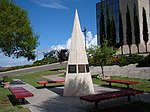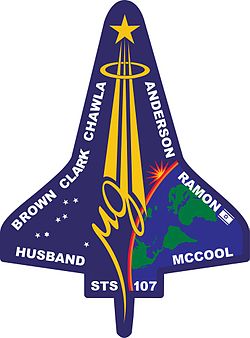STS-107
| STS-107 | |||||
 | |||||
| Uppdrag | 113 | ||||
|---|---|---|---|---|---|
| Rymdfärja | Columbia (28)[1] | ||||
| NSSDC-ID | 2003-003A[2] | ||||
| Färdens tid | 15 dagar, 22 timmar, 20 minuter, 32 sekunder | ||||
| Uppskjutning | |||||
| Startplats | Pad 39A vid Kennedy Space Center i Florida | ||||
| Start | 16 januari 2003 15:39:00 UTC | ||||
| Landning | |||||
| Landningsplats | Planerades till Kennedy Space Center i Florida | ||||
| Landning | Skytteln brann upp under återinträdet den 1 februari 2003 kl.~13:59:32 UTC | ||||
| Omloppsbana | |||||
| Varv | 255 st[3] | ||||
| Apogeum | 285 km | ||||
| Perigeum | 270 km | ||||
| Banlutning | 39,0° | ||||
| Sträcka | 10,6 miljoner km | ||||
| Besättning | |||||
| Befälhavare | Rick Husband (2) | ||||
| Pilot | William C. McCool (1) | ||||
| Uppdragsspecialister | Kalpana Chawla (2) Michael P. Anderson (2) Laurel Clark (1) David Brown (1) | ||||
| Nyttolastspecialister | Ilan Ramon (1) | ||||
 | |||||
| Kronologi Rymdfärjeprogrammet | |||||
| |||||

STS-107 var den 113:e flygningen i det amerikanska rymdfärjeprogrammet och tjugoåttonde och sista i ordningen för rymdfärjan Columbia. Rymdfärjan brann upp med besättning under återinträdet i jordens atmosfär 1 februari 2003.
Uppdraget
Rymdfärjan Columbia hade i lastutrymmet med sig Spacehab RDM dubbla laboratoriemoduler.
Nyttolaster och Experiment
- Experiment i Spacehab inkluderade nio kommersiella nyttolaster innehållande 21 olika experiment.
- Fyra nyttolaster från ESA innehållande 14 olika experiment.
- En nyttolast samt experiment för ISS risknedsättning.
- 18 nyttolaster innehållande 23 experiment för NASAs Office of Biological and Physical Research (OBPR).
Haveriet
Vid denna liksom tidigare uppskjutningar lossnade mindre bitar av isoleringsskum från den externa bränsletanken, men utan att väcka någon större uppmärksamhet. Denna gång kom obemärkt en ovanligt stor bit falla av och träffa rymdfärjan vid en särskilt utsatt position. Under återinträdet i atmosfären den 1 februari 2003 kunde markkontrollen se onormalt höga temperaturer i vingens struktur. Minuter senare bröts rymdfärjan sönder och farkosten totalförstördes och samtliga sju i besättningen omkom.
Detta var den andra olyckan med rymdfärjan där både besättning och farkost gick förlorade. Den första olyckan skedde i januari 1986 när Challenger havererade under uppdraget STS-51-L, men då redan 73 sekunder efter start och av andra orsaker.
Utredning
Efter olyckan tillsattes en utredning CAIB - Columbia Accident Investigation Board - som i augusti 2003 avrapporterade sina slutsatser i en omfattande rapport.[4]
Rapporten bekräftade den allmänt accepterade olycksorsaken att fragment av isoleringsskum lossnade vid uppskjutningen, vilket också kunde verifieras genom att studera videodokumentation. Att fragment lossnade var känt och accepterat, men denna gång kom obemärkt en ovanligt stor bit falla av och träffa och skada delar av rymdfärjans värmesköld vid en särskilt utsatt position. Detta fick förödande konsekvenser vid återinträdet i jordatmosfären då hettan från inbromsningen via skadan i skölden trängde in i delar av konstruktionen som inte tålde dessa temperaturer.
Man klarlade också att problemet med lossnande skumfragment var känt och uppträdde i varierande omfattning vid samtliga uppskjutningar, men att man med hjälp av övertygande powerpoint-presentationer hade förmedlat uppfattningen att risken för skador i farligt hög omfattning var "liten". Utredningen myntade begreppet "Engineering by Viewgraphs",[5] alltså ingenjörsanalyser och bevisföring med hjälp av presentationsteknik istället för beräkningar, tester och logiska resonemang.
Besättning
Besättningen ombord på Columbia bestod till större delen av förstagångsrymdflygare och hade en internationell besättning. Ilan Ramon blev Israels första astronaut i rymden.
- Rick Husband (2), befälhavare.
- William McCool (1), pilot
- Kalpana Chawla (2), uppdragsspecialist
- Michael P. Anderson (2), uppdragsspecialist
- Laurel Clark (1), uppdragsspecialist
- David Brown (1), uppdragsspecialist
- Ilan Ramon (1), nyttolastspecialist
- En väderradar i Shreveport, Louisiana detekterar Columbias sönderfall under återinträdet i atmosfären
- Minnesplakett på Marsrovern Spirit
Se även
Referenser
- ^ NASA Space Shuttle Launch Archive Arkiverad 29 maj 2012 hämtat från the Wayback Machine., läst 28 juli 2016.
- ^ ”NASA Space Science Data Coordinated Archive” (på engelska). NASA. https://nssdc.gsfc.nasa.gov/nmc/spacecraft/display.action?id=2003-003A. Läst 22 mars 2020.
- ^ Manned Astronautics - Figures & Facts Arkiverad 4 mars 2016 hämtat från the Wayback Machine., läst 28 juli 2016.
- ^ ”The Columbia Accident Investigation Board Report”. NASA. August 2003. https://history.nasa.gov/columbia/CAIB_reportindex.html. Läst 1 februari 2019.
- ^ ”The Columbia Accident Investigation Board Report, Vol 1, chapter 7”. NASA. 1 augusti 2003. sid. 191. https://history.nasa.gov/columbia/Troxell/Columbia%20Web%20Site/CAIB/CAIB%20Website/CAIB%20Report/Volume%201/Part%202/chapter7.pdf. Läst 25 mars 2022.
Externa länkar
 Wikimedia Commons har media som rör STS-107.
Wikimedia Commons har media som rör STS-107.
| ||||||||
| ||||||||||||||||||||||||||||||||
Media som används på denna webbplats
Emblem of Nasa's STS-114 mission.
- The STS-114 patch design signifies the return of the Space Shuttle to flight and honors the memory of the STS-107 Columbia crew. The blue Shuttle rising above Earth’s horizon includes the Columba constellation of seven stars, echoing the STS-107 patch and commemorating the seven members of that mission. The crew of STS-114 will carry the memory of their friends on Columbia and the legacy of their mission back into Earth orbit. The dominant design element of the STS-114 patch is the planet Earth, which represents the unity and dedication of the many people whose efforts allow the Shuttle to safely return to flight. Against the background of the Earth at night, the blue orbit represents the International Space Station (ISS), with the EVA crewmembers named on the orbit. The red sun on the orbit signifies the contributions of the Japanese Space Agency to the mission and to the ISS program. The multi-colored Shuttle plume represents the broad spectrum of challenges for this mission, including Shuttle inspection and repair experiments, and International Space Station re-supply and repair.
The crew of the final ill-fated flight of the Space Shuttle Columbia, mission STS-107, in October 2001.
This is the official crew photograph from mission STS-107 on the Space Shuttle Columbia. From left to right are mission specialist David Brown, commander Rick Husband, mission specialist Laurel Clark, mission specialist Kalpana Chawla, mission specialist Michael Anderson, pilot William McCool, and Israeli payload specialist Ilan Ramon.
All were killed when the shuttle disintegrated over Texas in February 2003.A plaque commemorating the astronauts who died in the tragic accident of the Space Shuttle Columbia is mounted on the back of the Mars Exploration Rover Spirit's high-gain antenna. The plaque was designed by Mars Exploration Rover engineers. The astronauts are also honored by the new name of the rover landing site, the Columbia Memorial Station. This image was taken on Mars by Spirit's navigation camera.
Författare/Upphovsman: Pascal (Flickr user: pasukaru76), Licens: CC0
Vostok spacecraft replica at the Technik Museum Speyer, Germany.
This is the crew patch for the STS-113 mission, which will be the eleventh American (11A) assembly flight to the International Space Station (ISS). The primary mission will be to take the Expedition Six crew to the ISS and return the Expedition Five crew to Earth. STS-113 will be the first flight in the assembly sequence to install a major component in addition to performing a crew exchange. The Port 1 Integrated Truss Assembly (P1) will be the first truss segment on the left side of the ISS. P1 will provide an additional three External Thermal Control System radiators, adding to the three radiators on the Starboard 1 (S1) Integrated Truss Assembly. The installation and outfitting of P1 will require three extravehicular activities (space walks) as well as coordination between the Shuttle Robotic Manipulator System and the Space Station Robotic Manipulator System. The patch depicts the Space Shuttle Endeavour docked to the ISS during the installation of the P1 truss with the gold astronaut symbol in the background.
The seven stars at the top left center of the patch are the seven brightest stars in the constellation Orion. They represent the combined seven crew members (four Shuttle and three Expedition Six). The three stars to the right of the astronaut symbol represent the returning Expedition Five crew members. The Shuttle crew names are on the solar arrays of the P6 truss. The ISS Expedition crew names are in a chevron that also features the American and Russian flags. The Expedition 6 crew names are on top of the Expedition 5 crew names, since Expedition 6 goes up while Expedition 5 goes down. The Roman Numeral CXIII represents the mission number 113.National Weather Service radar in Shreveport, Louisiana detects debris from the Space Shuttle Columbia (STS-107), which broke up on atmospheric re-entry
A diagram showing the payload bay configuration for STS-107, the twenty-eighth and final flight of the Space Shuttle Columbia (OV-102). In view (from left to right) are the SPACEHAB access tunnel, the SPACEHAB Research Double Module, the FREESTAR and OARE experiments (mounted to a Hitchhiker Multipurpose Equipment Support Structure), and the Extended Duration Orbiter (EDO) pallet.
Memorial garden and monument to the crews of Apollo 1, STS-51-L (Challenger), and STS-107 (Columbia). Located at the New Mexico Museum of Space History in Alamogordo, New Mexico; museum main building is at upper right.













